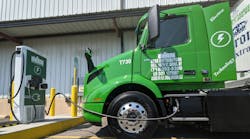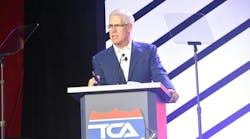TAMPA. The trucking industry has a number of obstacles both regulatory and operational in nature before it, according to Gov. Bill Graves, president & CEO of the American Trucking Assns. (ATA). Yet many of these challenges can and should be turned to trucking’s benefit over time, he emphasized in a speech given here at the 2011 Technology & Maintenance Council (TMC) annual meeting.
Graves emphasized that motor carriers remain embroiled in a “war” of sorts with a variety of groups seeking in his view to hamper the industry’s ability to maximize efficiency and productivity.
See more video "The challenges facing trucking"
“Make no mistake,” he said. “I can assure you that there are ‘anti-trucking’ groups operating around the country and certainly in Washington that mostly cloak themselves under the guise of ‘safety advocates. But I can tell you these organizations simply want to see fewer commercial vehicles traveling in this nation.”
Graves contended that “extreme environmentalists” and some factions within other freight modes are “increasingly concerned with the growing reliance on trucks to haul freight” in the U.S.
“But that is simply because America has a population now of over 300 million who choose to live and work in the far corners of this great nation of ours; areas that preclude the ability of most modes to deliver goods and services to them – except for trucks,” he stressed.
On the regulatory front, the ongoing effort to revise hours of service (HOS) rules continues to pose what Graves called “an obvious concern” for trucking. “We’re looking at changes that reduce productivity, affect the rest break of the driver and lengthen the time it takes to get assets back on the road,” he said. “And these changes are being proposed at a time when the industry has proved to be the safest it’s ever been.”
He pointed to recent Vehicle Miles Traveled (VMT) figures and safety data released by the Federal Highway Administration (FHWA) and the National Highway Transportation Safety Administration (NHTSA), respectively, to illustrate his position
The truck-involved fatality rate in 2008 declined 12.3% to 1.86 per 100 million miles from 2.12 per 100 million miles in 2007, marking the largest year-to-year drop ever and the fifth consecutive year the fatality rate has improved. Since 2005, when the last time newly revised HOS rules went into effect, the truck-involved fatality rate has come down more than 20% and is now at its lowest since the Dept. of Transportation began keeping such records in 1975.
“These latest figures underscore the trucking industry’s tremendous commitment to safety, and we continue to improve our safety performance while operating under current HOS rules,” Graves said.
He also pointed out that while ATA strongly supports the Federal Motor Carrier Safety Administration’s new Compliance Safety Accountability (CSA) program, the trucking lobby remains concerned that the intent of this new safety effort is being changed.
“We see great benefits with CSA to get bad drivers and bad carriers off the road; that’s good for all of us,” Graves emphasized. “But CSA as originally conceived was about doing ‘more with less.’ We are concerned that’s changing to doing ‘more with more,’” which could increase costs to trucking companies, he explained.
Graves also stressed that the industry should get used to the idea of electronic on-board recorders (EOBRs) becoming at some point required technology for all carriers. “It’s not a question of ‘if,’ it’s a question of ‘when,’” he said. “It’s simply going to happen; we’re on the flight path to have EOBRs on every commercial vehicle within the next few years. “
See more video "The challenges facing trucking"
The industry should get behind EOBRs, Graves believes, because studies are now beginning to correlate a strong link between those devices and safety performance improvements. “As we start seeing that connection, it will be very difficult to opposed acceptance of this technology,” he said.
One bit of good news, ne noted is that Congress is beginning to take what he called “a hard look” at how fuel taxes are spent. While efforts to raise fuel taxes to boost infrastructure spending are pretty much a dead issue on Capitol Hill, according to Graves, the effort to shift fuel-tax spending away from “non-road” projects such as walking paths and bike lanes and back solely to roads and bridges is in his words “a very good start.”
Finally, Graves mentioned that efforts to increase the federal weight limit for heavy trucks are getting “a fairly strong reception” now on Capitol Hill, and at the very least, he expects more pilot programs to be approved with the highway funding bill now being worked on in Congress.
“We really owe it to ourselves and to the nation to find ways to boost the productivity and efficiency of trucks to help support the economic recovery in this country,” he stressed. “If either heavier or longer combination vehicles can help this industry deal with a growing shortage of drivers and higher equipment costs, we need to look at them.”




